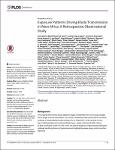Exposure Patterns Driving Ebola Transmission in West Africa: A Retrospective Observational Study
Agua-Agum, Junerlyn
Ariyarajah, Archchun
Aylward, Bruce
Bawo, Luke
Bilivogui, Pepe
Blake, Isobel M.
Brennan, Richard J.
Cawthorne, Amy
Cleary, Eilish
Clement, Peter
Conteh, Roland
Cori, Anne
Dafae, Foday
Dahl, Benjamin
Dangou, Jean-Marie
Diallo, Boubacar
Donnelly, Christl A.
Dorigatti, Ilaria
Dye, Christopher
Eckmanns, Tim
Fallah, Mosoka
Ferguson, Neil M.
Fiebig, Lena
Fraser, Christophe
Garske, Tini
Background: The ongoing West African Ebola epidemic began in December 2013 in Guinea, probably from a single zoonotic introduction. As a result of ineffective initial control efforts, an Ebola outbreak of unprecedented scale emerged. As of 4 May 2015, it had resulted in more than 19,000 probable and confirmed Ebola cases, mainly in Guinea (3,529), Liberia (5,343), and Sierra Leone (10,746). Here, we present analyses of data collected during the outbreak identifying drivers of transmission and highlighting areas where control could be improved. Methods and Findings: Over 19,000 confirmed and probable Ebola cases were reported in West Africa by 4 May 2015. Individuals with confirmed or probable Ebola (“cases”) were asked if they had exposure to other potential Ebola cases (“potential source contacts”) in a funeral or non-funeral context prior to becoming ill. We performed retrospective analyses of a case line-list, collated from national databases of case investigation forms that have been reported to WHO. These analyses were initially performed to assist WHO’s response during the epidemic, and have been updated for publication. We analysed data from 3,529 cases in Guinea, 5,343 in Liberia, and 10,746 in Sierra Leone; exposures were reported by 33% of cases. The proportion of cases reporting a funeral exposure decreased over time. We found a positive correlation (r = 0.35, p < 0.001) between this proportion in a given district for a given month and the within-district transmission intensity, quantified by the estimated reproduction number (R). We also found a negative correlation (r = −0.37, p < 0.001) between R and the district proportion of hospitalised cases admitted within ≤4 days of symptom onset. These two proportions were not correlated, suggesting that reduced funeral attendance and faster hospitalisation independently influenced local transmission intensity. We were able to identify 14% of potential source contacts as cases in the case line-list. Linking cases to the contacts who potentially infected them provided information on the transmission network. This revealed a high degree of heterogeneity in inferred transmissions, with only 20% of cases accounting for at least 73% of new infections, a phenomenon often called super-spreading. Multivariable regression models allowed us to identify predictors of being named as a potential source contact. These were similar for funeral and non-funeral contacts: severe symptoms, death, non-hospitalisation, older age, and travelling prior to symptom onset. Non-funeral exposures were strongly peaked around the death of the contact. There was evidence that hospitalisation reduced but did not eliminate onward exposures. We found that Ebola treatment units were better than other health care facilities at preventing exposure from hospitalised and deceased individuals. The principal limitation of our analysis is limited data quality, with cases not being entered into the database, cases not reporting exposures, or data being entered incorrectly (especially dates, and possible misclassifications). Conclusions: Achieving elimination of Ebola is challenging, partly because of super-spreading. Safe funeral practices and fast hospitalisation contributed to the containment of this Ebola epidemic. Continued real-time data capture, reporting, and analysis are vital to track transmission patterns, inform resource deployment, and thus hasten and maintain elimination of the virus from the human population.
No license information

